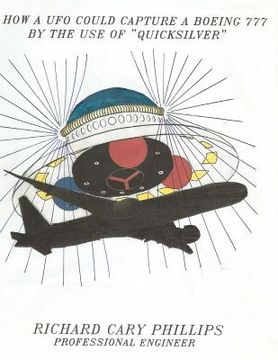Compartir
How A UFO Could Capture a Boeing 777 By The Use Of "Quicksilver" (en Inglés)
Richard Cary Phillips Pe
(Autor)
·
Createspace Independent Publishing Platform
· Tapa Blanda
How A UFO Could Capture a Boeing 777 By The Use Of "Quicksilver" (en Inglés) - Phillips Pe, Richard Cary
$ 47.37
$ 60.00
Ahorras: $ 12.63
Elige la lista en la que quieres agregar tu producto o crea una nueva lista
✓ Producto agregado correctamente a la lista de deseos.
Ir a Mis Listas
Se enviará desde nuestra bodega entre el
Lunes 27 de Mayo y el
Martes 28 de Mayo.
Lo recibirás en cualquier lugar de Estados Unidos entre 1 y 3 días hábiles luego del envío.
Reseña del libro "How A UFO Could Capture a Boeing 777 By The Use Of "Quicksilver" (en Inglés)"
Richard C. Phillips was born in Starkville, MS on April 5, 1934. He grduated from Auburn University in 1957 with a Bachelor's Degree in Mechanical Engineering. Later, he obtained his Professional Engineer's Licenses in the states of Georgia and Alabama. His interest in "Flying Saucers" started in the fall of 1968, at Port Canaveral, FL, while working for the Boeing Company as a "Lead Engineer" in the Facilities Department on the Saturn V Apollo Program to get man on the moon. While watching a "Minute Man Missile" being launched from Cape Canaveral, a so-called "Flying Saucer" suddenly flew down from the sky while he and his son were outside their home watching the "Minute Man Missile". The so-called "Flying Saucer" stopped directly over their heads at a distance of no more than 25 feet. In 1973, Mr. Phillips had a renewed interest in how this marvelous flying machine operated and dedicated most of his spare time in getting as much information as possible to get some clues as to how this unbelievable craft operated. Slowly, during the next 21 years, he researched and analyzed many photographs and APRO reports to get as much information as possible. This information was checked out for accuracy in college physics books that he had studied in college - mainly in Electricity and Magnetism. Finally, through trial and error, he produced the architectural design of a "spacecraft engine" that could propel a spacecraft at 1000's of miles per hour that coincided exactly with the physical description of the craft that he witnessed in 1968 when the craft was hovering 25 feet above their heads. Later, he acquired two US Patents depicting the principles used in the propulsion systems of the so-called "Flying Saucers". These principles have been checked out by the world's best Engineers, Scientists, and Physicists at the US Patent Office, and they have stated that this invention is a useful product for mankind. These patents are included in this book.
- 0% (0)
- 0% (0)
- 0% (0)
- 0% (0)
- 0% (0)
Todos los libros de nuestro catálogo son Originales.
El libro está escrito en Inglés.
La encuadernación de esta edición es Tapa Blanda.
✓ Producto agregado correctamente al carro, Ir a Pagar.

